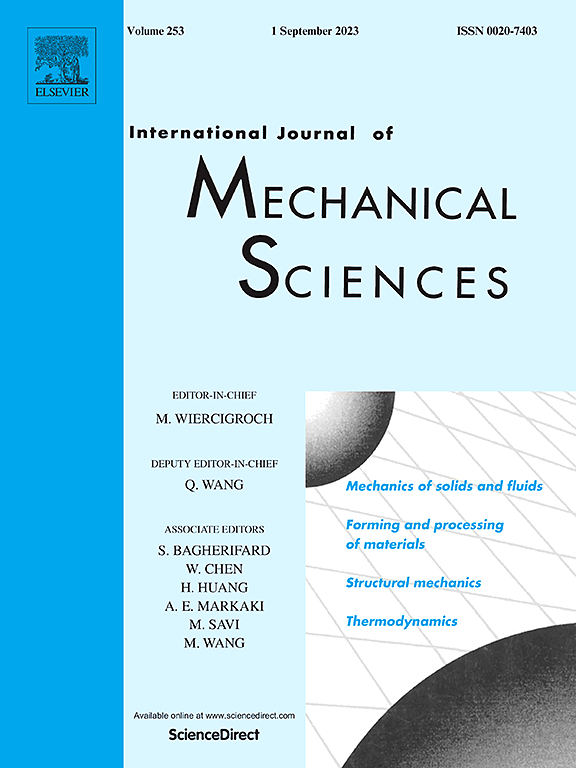Extraordinary specimen-size effect on long-life fatigue of additively manufactured AlSi10Mg
IF 7.1
1区 工程技术
Q1 ENGINEERING, MECHANICAL
International Journal of Mechanical Sciences
Pub Date : 2025-06-22
DOI:10.1016/j.ijmecsci.2025.110524
引用次数: 0
Abstract
It is well known that the mechanical properties of materials are strongly influenced by the size of the testing specimens, especially for the defect-induced high-cycle fatigue (HCF) and very-high-cycle fatigue (VHCF) of high-strength alloys with failure cycles beyond 107. Typically, this phenomenon of specimen-size effect becomes more pronounced as the fatigue life extends, and the fatal fatigue-crack initiates within a risk domain of control volume V90 where the applied stress is equal or larger than 90 % of the nominal one.
Here, for the first time, we report a newly observed specimen-size effect on fatigue behavior of an additively manufactured aluminium alloy (AlSi10Mg) produced by powder bed fusion - laser beam. Fatigue tests were precisely conducted by ultrasonic cycling at a resonant frequency of 20 ± 0.5 kHz under a stress ratio R = –1 at room temperature and in ambient air. Five types of specimens with minimal diameters of 3.5, 5.3, 8.1, 12.25 and 18.6 mm were tested. As specimen size increases, the HCF resistance drops sharply and exhibits a large scatter, whereas the VHCF limit degrades only slightly. For small-sized types, fatal crack initiates at specimen surface, subsurface or interior with the increasing failure cycles. But for large-sized types, fatal crack nucleates frequently in specimen interior even with “fish eye” morphology in HCF regime. Furthermore, the crack initiation site gradually tends to shift beyond the control volume part with the increase of specimen size, making the concept of V90 challenging for large-sized specimens, regardless of fatigue lives.

材料尺寸对增材制造AlSi10Mg长寿命疲劳的影响
众所周知,材料的力学性能受试样尺寸的强烈影响,特别是高强度合金的缺陷诱发高周疲劳(HCF)和甚高周疲劳(VHCF)失效周期超过107。通常情况下,随着疲劳寿命的延长,这种试样尺寸效应的现象变得更加明显,并且在施加应力等于或大于标称应力的90%的控制体积V90的风险域内开始致命疲劳裂纹。在这里,我们首次报道了新观察到的样品尺寸对粉末床熔合-激光束增材制造铝合金(AlSi10Mg)疲劳行为的影响。在室温和环境空气条件下,在应力比R = -1条件下,以共振频率20±0.5 kHz的超声循环精确地进行了疲劳试验。试件最小直径分别为3.5、5.3、8.1、12.25和18.6 mm。随着试样尺寸的增大,HCF电阻急剧下降,呈现较大的散射,而VHCF极限仅略有下降。对于小型试样,随着破坏循环次数的增加,在试样表面、地下或内部产生致命裂纹。但对于大尺寸型,即使在HCF条件下具有“鱼眼”形态,致命裂纹也经常在试件内部形核。此外,随着试样尺寸的增大,裂纹起裂部位逐渐向控制体积部分以外偏移,使得无论疲劳寿命如何,大尺寸试样的V90概念都具有挑战性。
本文章由计算机程序翻译,如有差异,请以英文原文为准。
求助全文
约1分钟内获得全文
求助全文
来源期刊

International Journal of Mechanical Sciences
工程技术-工程:机械
CiteScore
12.80
自引率
17.80%
发文量
769
审稿时长
19 days
期刊介绍:
The International Journal of Mechanical Sciences (IJMS) serves as a global platform for the publication and dissemination of original research that contributes to a deeper scientific understanding of the fundamental disciplines within mechanical, civil, and material engineering.
The primary focus of IJMS is to showcase innovative and ground-breaking work that utilizes analytical and computational modeling techniques, such as Finite Element Method (FEM), Boundary Element Method (BEM), and mesh-free methods, among others. These modeling methods are applied to diverse fields including rigid-body mechanics (e.g., dynamics, vibration, stability), structural mechanics, metal forming, advanced materials (e.g., metals, composites, cellular, smart) behavior and applications, impact mechanics, strain localization, and other nonlinear effects (e.g., large deflections, plasticity, fracture).
Additionally, IJMS covers the realms of fluid mechanics (both external and internal flows), tribology, thermodynamics, and materials processing. These subjects collectively form the core of the journal's content.
In summary, IJMS provides a prestigious platform for researchers to present their original contributions, shedding light on analytical and computational modeling methods in various areas of mechanical engineering, as well as exploring the behavior and application of advanced materials, fluid mechanics, thermodynamics, and materials processing.
 求助内容:
求助内容: 应助结果提醒方式:
应助结果提醒方式:


